U.appoints first HBCU presidential fellow
Elfred Anthony pinkard to lead HBCU partnership set to launch in 2023-24
BY ANIYAH NELSON SENIOR STAFF WRITERElfred Anthony pinkard, the current president of Wilberforce University in Ohio, was named Brown’s inaugural HBCU presidential Fellow, according to an April 11 University press release. pinkard will begin at Brown July 1.
In his role, pinkard will lead efforts to build on the Brown-Tougaloo partnership and organize a program — set to launch during the 2023-24 academic year — that will expand the University’s collaboration with historically Black
colleges and universities in addition to its existing relationship with Tougaloo, sylvia Carey-Butler, vice president for institutional equity and diversity, said in the release.
“I was really drawn to the idea that an institution with the stature and re-
UNIVERSITY NEWS
Unknown individual shatters UHall window
occurred aside from broken glass from the window.
s ome students shared videos and images of the broken window with the @BrownUMemes Instagram account.
BY JULIA VAZ METRO EDITORsources of Brown, with its historic and successful relationship with Tougaloo (College), can work together through an iterative process to support these institutions,” pinkard said in the release.
On April 10, multiple videos circulated of an individual throwing a softball to themselves and hitting it against University Hall, breaking the window to the p rovost’s Office. According to University s pokesperson Brian Clark, University staff members were present in the room when the window shattered, but no injuries or damage
“It was not immediately clear whether this was an accident or a deliberate act,” Clark wrote in an email to The Herald. According to Clark, the Department of p ublic s afety is currently investigating the incident.
In response to requests for comment, D ps and p rovost Larry Larson both deferred to Clark’s comment.
This is a developing story. Check browndailyherald.com for updates.
Decolonization group looks ahead after restructuring
UNIVERSITY NEWS Organization seeks to inform about U. history, Indigenous communities
BY JENNIFER SHIM SENIOR STAFF WRITERAfter taking a hiatus last semester to evaluate its “work and capacities,” Decolonization at Brown is rebuilding its activism efforts within a newly restructured organization.
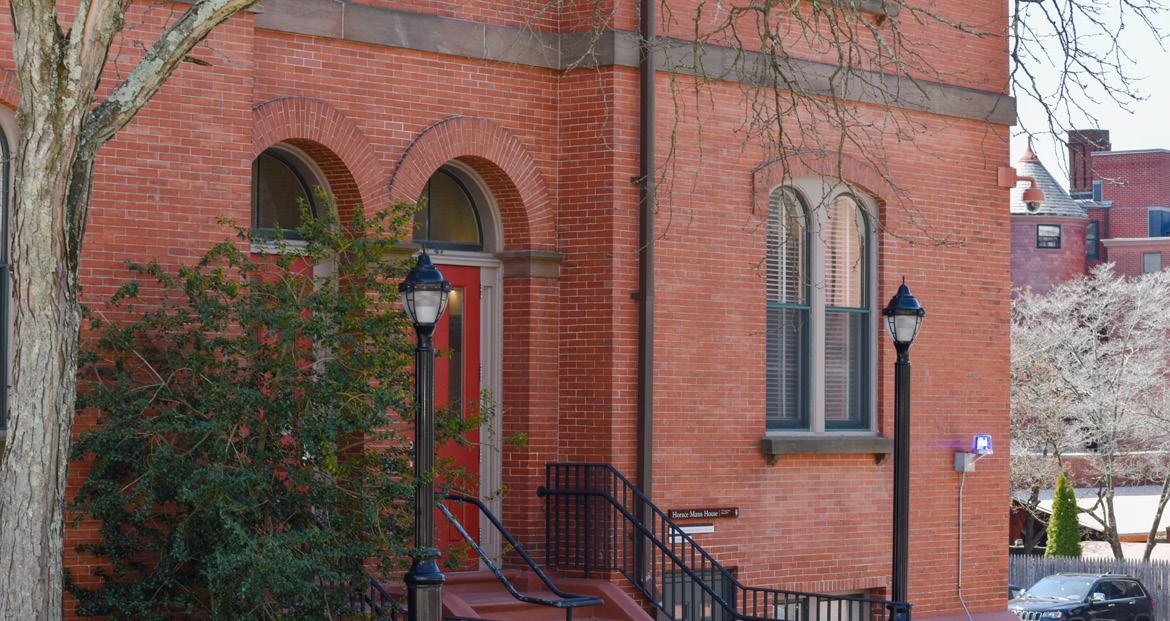
The group “seeks to bring together students, staff, faculty and local communities to work towards decolonizing Brown’s relationships, academics and spaces,” according to its informational pamphlet.
The organization is also “dedicated to making sure the Indigenous histories of (the University and p rovidence) … are properly conveyed and represented,” said s hazain Khan ’24, a member of DAB’s steering committee and a coordinator for the group’s restructuring.
One of DAB’s current initiatives is the Carte Blanche task force, a decolonial magazine and podcast headed by Maha Temre ’25. According to DAB’s pamphlet, “carte blanche” — which translates to “white card” — implies “a complete freedom to act as one wishes.”
Temre said that this title “embodies the spirit of the project,”

which aims to offer “complete freedom to finally speak about topics that are not spoken about enough, especially in the media.”
Temre first had the idea for the project this past summer, and she later reached out to DAB, which has provided funding for its further development. The project focuses on how colonialism affects not only “our daily lives” but also “our minds,” she said.
“That gives us a foundation to be able to speak about a variety of topics, such as language, gender (and) mental health,” Temre added.

Khan and Cami Regalia ’24, who leads the Colonialism in s TEM task force, also both expressed interest in reviving a past DAB event titled “What is This p lace?”

The event served as an educational opportunity for University students to learn about the institution’s colonial history and ties to the slave trade.
They also hope to strengthen the organization’s anti-misinformation task force, which aims to share information about the histories of p rovidence’s Indigenous communities and how they were impacted by settler colonialism.
“I don’t want to speak for what DAB could be, because I want DAB to be what the community needs it to be,” Khan said. “My hope is for DAB to revive that energy, that enthusiasm, that motivation to
SEE DAB PAGE 5
Analyst says U. can pay professors more
UNIVERSITY NEWS professors voice frustration with administration at AAUp presentation
BY CHARLIE CLYNES UNIVERSITY NEWS EDITORHoward Bunsis, professor of accounting at Eastern Michigan University and former chair of the American Association of University professors’ Collective Bargaining Congress, presented an independent analysis of Brown’s finances in a Zoom presentation hosted by Brown’s AAUp chapter Monday. speaking to nearly 100 faculty attendees, Bunsis claimed that the University is in a strong financial position to increase professors’ pay and benefits, despite alleged communications from administrators to faculty members suggesting otherwise.
The AAUp seeks to promote academic freedom and “shared governance” in addition to organizing the higher education community, according to its website.
The presentation included a broad overview of the University’s finances — including a breakdown of its total assets, investments and investment performance, reserves, bond rating, changes in faculty composition and faculty salaries in comparison to peer institutions — followed by a question-and-answer session in which multiple faculty members expressed discontent with their compensation.
Months into the COVID-19 pandemic in 2020, the University announced a 12-month reduction in retirement
contributions for non-unionized employees, including faculty, to help offset the pandemic’s economic impacts, though it halted the reduction after four months. The University’s financial outlook improved in 2021, when the Investment Office announced 51.5% endowment returns on the fiscal year. Operating cash flows were also positive in four out of the last five years, according to the presentation. But faculty wages have increased below the rate of inflation in the last two years, and tuition and auxiliary revenue in 2022 were higher than pre-COVID-19 levels, Bunsis said, citing AAUp statistics.
University spokesperson Brian Clark disputed Bunsis’s characterizations in an email to The Herald.
“The AAUp presentation to faculty on University finances included inaccuracies, misrepresentations of data and additional issues that lacked full context,” Clark wrote. “While the presenter used publicly available data through
fiscal year 2022 to illustrate significant growth in year-over-year revenues at Brown, he did not properly contextualize why revenues and expenses changed so dramatically.”
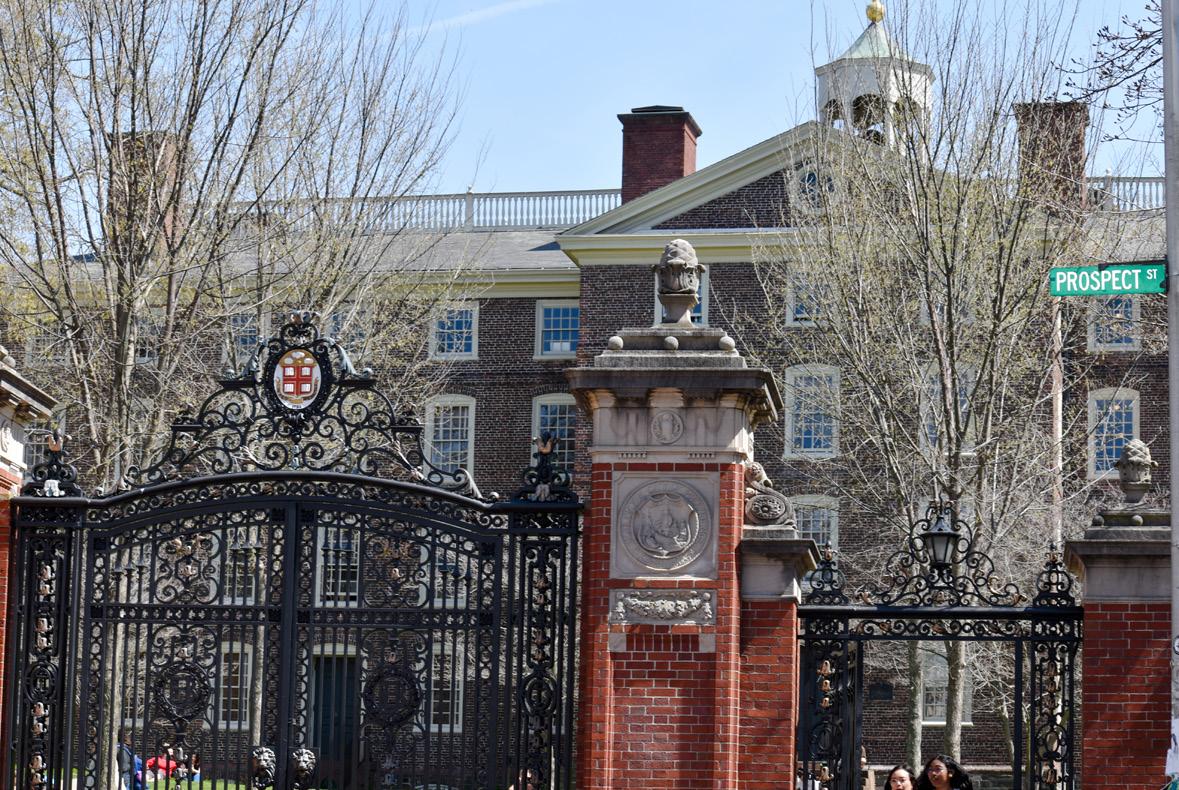
Clark noted that some revenue from fiscal year 2021 was recorded in fiscal year 2022 due to the three-semester model used in the 2020-21 academic year as the third semester crossed between fiscal years.
Bunsis also discussed a 42.8% increase in faculty hired as lecturers and senior lecturers between 2018 and 2023. “A lecturer does not have the same academic freedom, rights and security as someone who’s a full-time faculty member.”
Non-tenure-track faculty now teach more than half of the classes at Brown, according to the presentation.
Clark wrote that the University has added non-tenure-track faculty for the
SEE AAUP PAGE 5
Dps currently investigating if incident was deliberate act, U. saysDANA RICHIE / HERALD The presentation included an overview of Brown’s finances, including changes in faculty composition and salaries compared to peer institutions. DANA RICHIE / HERALD Pinkard currently leads Wilberforce University in Ohio, which is the nation’s oldest private HBCU. SEE
“RyeLane” offers creativity but lacks sensationalism
BCSC announces new assistant director, program coordinator
Ajeé schaeffer, Gizzelle Fernandez bring experience in educational leadership
BY SWARAJ AGARWAL SENIOR STAFF WRITERThe Brown Center for s tudents of Color announced Ajeé s chaeffer as the center’s new assistant director and Gizzelle Fernandez as program coordinator in an April 3 email announcement by Associate Dean and Director of the BC s C Vincent Harris. s chaffer will oversee the BC s C’s Third World Transition p rogram and Minority peer Counselor program. Fernandez oversees the center’s outreach and communications efforts — including its open houses and campus-wide events — as well as logistics. s chaffer started at the center March 31, and Fernandez began March 29.
“Becoming a program coordinator for the (BCsC) is such an exciting moment in my life,” Fernandez wrote in an email to The Herald. “I am joining an amazing team that has worked so hard to create enriching events for students to partake in and can’t wait
ARTS & CULTURE
to support them in every way.”
“I’m beyond excited to learn and be in a community with our amazing students,” s chaeffer wrote in an email to The Herald. “I look forward to learning and being an active part of the Brown University community.”
s chaeffer comes to Brown from the Excel Academy Charter s chools in p rovidence, where she was founding dean of school culture. Before working at Excel Academy, s cha ef-
fer served as assistant principal and associate dean of students at the s uccess Academy Charter s chool in New York.
Fernandez arrives at the BC s C from the Warren Alpert Medical s chool, where she served as curriculum coordinator and as a financial aid counselor for students in the p rogram in Liberal Medical Education.
Both s chaeffer and Fernandez’s experiences in leadership roles at
educational institutions impressed their respective search committees, Harris wrote in an email to The Herald. The search process for the two roles involved input from students, faculty, staff and members of the Office of Campus Life.
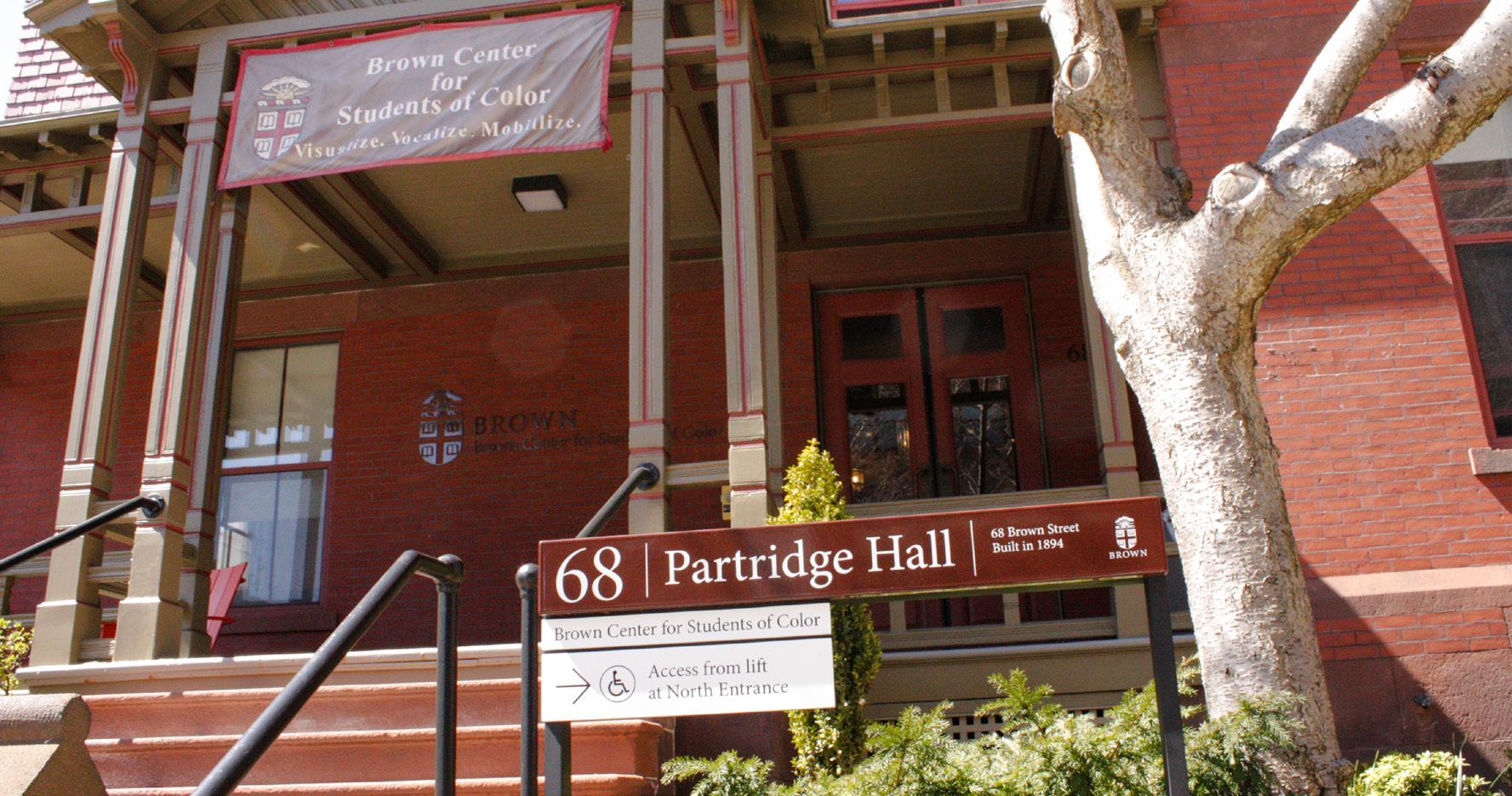
“ p revious positions I’ve held, from school operations to being an assistant principal and dean of culture, have not only built my passion for working with students but pro -
vided me the tools to be successful in a role like the Assistant Director of the BC s C,” s chaeffer wrote.
Fernandez added that as a person of color, she recognizes the need for a university environment to be safe and comfortable for students. “I strive to continue the great work that the (BC s C) has done throughout the years by using the skills I learned at (Warren Alpert) and utilizing it at the center,” Fernandez wrote.
“It’s been such a pleasure seeing the students’ involvement and leadership at the BC s C which affirms that I made the correct decision to join the BC s C family,” s chaeffer wrote.
Fernandez added that her experience at Brown so far “has been very positive” and she has worked with “great mentors” at the center.
“Working alongside Ajeé and Gizzelle has been exciting and encouraging as it has been energizing to see the beginnings of their collaboration with the team,” Harris wrote in an email to The Herald. “Throughout their onboarding process, both have been engaging with our student leaders regularly, planning meetings with Campus Life colleagues and anticipating growing their connections across the University.”
‘Rye Lane’: A glimmer of hope for the romantic comedy genre
First-time director Allen-Miller fits classic rom-com mold with creativity, authenticity
FINN KIRKPATRICK ARTS & CULTURE EDITORThe romantic comedy has always been an integral part of film history — but not without its fair share of ups and downs. From the early classics such as “It Happened One Night” to later incarnations like “When Harry Met s ally,” the genre’s form has been able to rise to the top of film discussions time and time again. But in recent years, rom-coms have hit a bit of a snag.
These films have almost been completely co-opted by Netflix, which stuffs them with actors that have all the looks but none of the personality, reading lines off a script that might as well be written by poorly programmed AI. It’s yet to be determined if “Rye Lane,” a new rom-com released on Hulu by first-time director Raine Allen-Miller, will be the film to breathe life back in the genre. A pessimist would say it probably isn’t. s till, the film presents a very promising glimmer of hope. With a clear stylistic vision and actors playing characters that feel like actual people, the movie is a much needed creative endeavor in this time-honored cinematic tradition.
The rom-com is able to persist because its structure has been battle-tested for nearly a century. Two subjects, both in a precarious position in their lives one way or another, meet by some quirk of fate. The chemistry between them is immediately palpable and their lives are flipped upside down after their first
meeting. The bond grows and grows until a crucial moment tears them apart. But ultimately the relationship they formed is stronger than any petty differences that can get in the way, and they stroll off into the sunset happier than ever before.
“Rye Lane” never breaks free from this rigid mold, and because of that, it works. In sticking closely to the standard rhythms of the rom-com, the film reveals an honest humanity that exists just under the surface of what can easily be perceived as a superficial structure.
The two leads of the movie are Dom (David Jonsson) and Yas (Vivian Oparah). Dom has just broken up with his girlfriend of six years and is not taking it well. He embarks on his first major trip out of his house to attend his friend’s art gallery opening, where he encounters Yas. Her assertive personality immediately contrasts with Dom’s more shy and reserved nature. But sparks are clearly there, and as the gallery ends, they are still together, left to roam about London and get to know each other.
The cause of Dom’s breakup comes from the fact that his ex, Gia (Karene peter) cheated on him with his best friend Eric (Benjamin s arpong-Broni). Dom is supposed to go get lunch with them to clear the air, but Yas crashes the meeting after hearing about the whole ordeal. she’s able to counteract Dom’s lack of assertion and expose Gia for the manipulative person she truly is. When the meeting ends, their relationship seems even stronger.
As the film develops, its impeccable style carries it to become an all-encompassing experience. Using wide angles and fisheye lenses, the cinematography is able to capture an off-kilter aesthetic that makes the movie have a personality of its own.
This style is then complemented by
lead actors — both relative newcomers — who are able to capture the viewers’s complete attention. While the structure of its story is nothing new, the lack of sensationalism that the film applies to it is certainly a breath of fresh air. The film, which takes place in a s outh London neighborhood far from the bustle of the city, situates viewers among a community of real people living their own

lives. It’s through little touches — like an interaction between Dom and Yas where viewers see a neighbor peek their head out of their flat to listen for a little bit before going back to their own separate lives — that this is achieved.
Brief breaks into surrealism provide moments of new fun that make sure the movie is never a bore. When Dom and Yas tell stories of their past
relationships, they see them appear as if they are audience members watching a play, all while accounting for the fog of mistruth that comes when one person tells their side of a two-person story.
“Rye Lane” is a fun watch that doesn’t take itself too seriously, but it’s also a unique piece of filmmaking with creative twists that make it a joy to experience.
Quiz bowl team wins undergraduate championship at national meet
Team places eighth overall in pool of undergraduate, graduate teams
BY RYAN DOHERTY SENIOR STAFF WRITERBrown’s quiz bowl team won the undergraduate division of the Intercollegiate Championship Tournament on April 1. The team placed eighth overall in the tournament, which included undergraduate teams and open teams of graduate and undergraduate students.
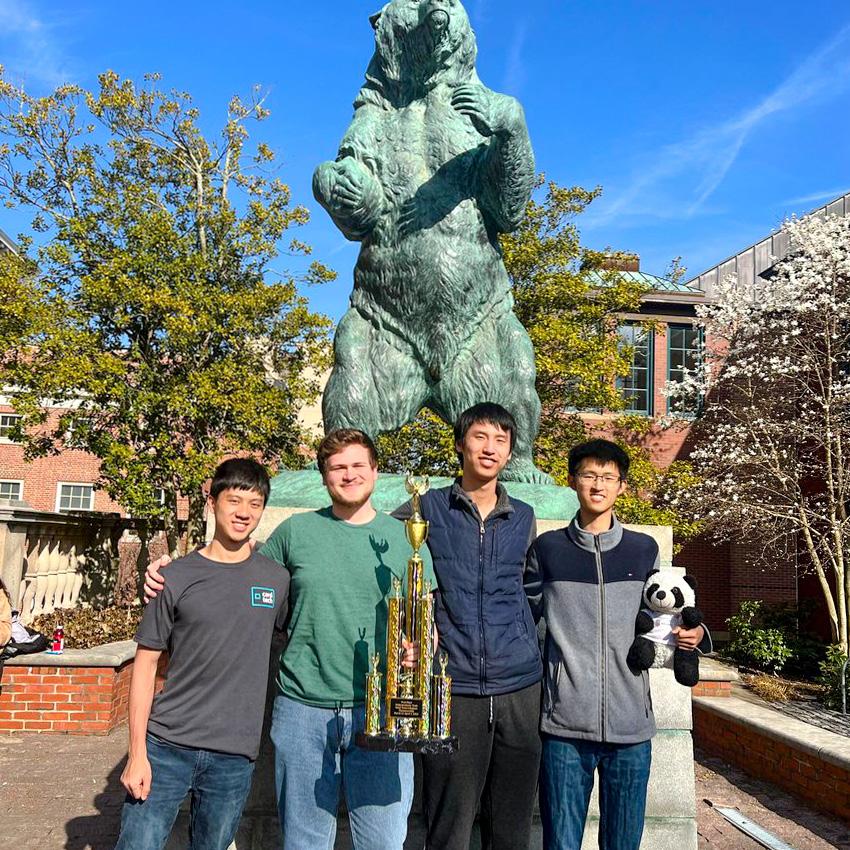
Quiz bowl is a competition in which two teams face off against each other in “academic trivia,” including “literature, history, science (and) the arts,” said Anson Berns ’23, the team’s captain.
The event was hosted by National Academic Quiz Tournaments, the largest provider of quiz bowl competitions, according to their website. The team won the undergraduate division of the tournament in 2021, which was held virtually due to the COVID-19 pandemic.
The Herald spoke with the team’s four members — Berns, Jason Hong ’24, Walter Zhang ’23 and Michael Li ’23 — about their path to the national championship.
This year’s championship started off with delays for members traveling to the competition. “There were huge storms in Chicago, so all of our flights were delayed (or) canceled,” Berns said. “I got to Chicago (only) a couple
UNIVERSITY NEWS
of hours … before the games started.”
Despite these issues, when the team arrived at the ICT in Rosemont, Illinois, they quickly found success.
In the preliminary rounds, the team
won six out of seven games to earn a place in pool A, the competition’s highest bracket, for their playoff matches against teams which included graduate students. According to
Berns, this was the first time Brown’s team made the top pool.
Brown was the only entirely undergraduate team in pool A, according to the NAQT website. Brown’s
team lost all seven of its playoff matches against open team opponents.
“Most of them were really competitive, and they went down to the last few questions,” Hong said. “We tried our best.”
Despite their losses, Brown ended the playoffs as the highest-ranked undergraduate team. Facing Columbia in the undergraduate final, Brown found a decisive victory with a final score of 380-90.
“We thought we were better than (Columbia), and we were expecting to win,” Berns said. “It’s still a really good feeling to be undergrad champions.”
“It felt better winning a real in-person tournament,” he added.
The team attributed their success to their past experience working together. Berns, Zhang and Li joined the team their freshman year when some of the upperclassmen left the organization. “It was up to us to rebuild the club,” Zhang said. After Hong joined the following year, they were able to create a stable team for competitions.
“The four of us have been playing together for quite a long time … so I think we’re all pretty comfortable with each other in high-pressure situations,” Berns explained.
The team will compete at another national-level tournament at the Massachusetts Institute of Technology in the coming weeks and hopes to achieve similar results.
“We’re going to try to win the undergrad championship and place highly (there) as well,” Berns said.
Rep. Seth Magaziner ’06 talks abortion, extremism, TikTok at event
First-term House representative, alum makes first visit back to Brown since election
BY OWEN DAHLKAMP SENIOR STAFF WRITERWhen former Rep. Jim Langevin unexpectedly retired in early 2022, the “first thing that came into … mind” for Rep. s eth Magaziner ’06 was January 6th, Magaziner said at an event hosted by the Brown College Democrats on Tuesday. Magaziner told students that when running for office, candidates “need to have a reason. And that was my reason.”
Magaziner, who was running for governor of Rhode Island when the seat opened up, quickly shifted his candidacy to focus on the second district — moving from p rovidence to Cranston to establish residence in the district. Magaziner won a tightly contested election with former Cranston Mayor Allan Fung by under five percent of the vote, joining the Democratic House minority.
Cecilia Marrinan ’24, president of Brown Democrats, introduced Magaziner, who “was president of the Brown College Democrats” in his time at the University.
While at Brown, Magaziner said that he “learned more from being a part of the Brown Dems than I did anything else.”
“I would not be a member of Congress without the work of the Brown Democrats,” Magaziner noted, thanking them for their work on his campaign last fall.
At Brown — his first time back at the University since joining the U.s House of Representatives — Magaziner discussed a litany of issues — ranging from abortion access and radicalization to TikTok and gun control.

In an interview with The Herald following the event, Magaziner said Republicans are “trying to ban abortion nationally. We can’t let it happen.” He also expressed support for “codifying the right to an abortion nationally.”
“Despite what the Republicans
will say,” Magaziner said at the event, “we know that their agenda is a national abortion ban that includes Rhode Island.”
“That’s what this crazy ruling out of Texas the other day was all about,” he said, referring to a Trump-appointed federal judge invalidating the 23-year-old FDA approval of mifepristone, a pill commonly used in medical abortions. The ruling is directly at odds with a separate ruling from Washington state that maintains the drug’s legal status.
At the event, Magaziner also discussed his focus on domestic extremism, noting that he requested to be placed on the Homeland s ecurity Committee to “protect our democ -
racy, particularly from domestic extremists.”
“I think the Republicans in Congress are nervous about having too much of a focus on far-right extremism because in some cases, they are personally complicit,” Magaziner said at the event. He cited the examples of Georgia Rep. Marjorie Taylor Greene and Arizona Rep. p aul Gosar, calling them “complicit in stoking anti-democratic violence.”
When asked about the recent bomb threat against the Brown Muslim s tudent Association, which was motivated by Islamophobic sentiment, Magaziner said after the event that “people shouldn’t have to live like this. It’s not something that we
can normalize, and not something that we need to accept.”
He also noted in the interview that law enforcement agencies need more resources to investigate “racially motivated and religiously motivated domestic extremism,” and advocated for increased availability of mental health services “so that we can help prevent people from being radicalized.”
At the event, Magaziner discussed recent congressional hearings about Chinese ownership of TikTok. “I think like with any industry, you have to find the balance between creating safe spaces for innovation and expression, but also protecting consumers,” he said.
While undecided on an outright ban of TikTok in the United s tates, Magaziner expressed support for banning the app from government phones. “I understand that some of the concerns that people have about TikTok are very real concerns that the Chinese government or other bad actors could … access other data on other applications as well.”
Magaziner also touched on his hopes to address climate change, education and gun violence during the panel.
Noah Rosenfeld ’24, vice president of Brown Dems, said he hoped that attendees left “the event with a little bit more knowledge of what’s happening in D.C., what it means to be a first-term congressman and what it means to campaign for Congress.”
Brown among highest Fulbright-producing institutions in the nation
munity-oriented research in a way that I feel is ethical, meaningful and mutually beneficial.”
BY ANNIKA SINGH CONTRIBUTING WRITERBrown produced the third-highest number of Fulbright students among U. s . colleges in the 2022-23 cohort with 30 grant recipients, according to U.s. Department of state data.
For seven straight years, the University has ranked among the top Fulbright-producing institutions, In four of those years, the University was ranked first for the production of Fulbright award winners, The Herald previously reported.
The Fulbright U. s s tudent p rogram provides more than 1,800 graduating seniors, graduate students and recent alums with grants to “study, research or teach abroad,” according to the program’s website.
These numbers reflect the number of students in the current cohort, while the 2023-24 cohort will learn about their awards this spring, according to a University press release.
Fulbright represents “an invitation to follow the path of exploration, self-direction/discovery and rich engagement with a broad world that Brown’s curriculum encourages,” Associate Dean of the College for Fellowships Linda Dunleavy wrote in an email to The Herald. “I think Brown’s success with the Fulbright program largely rests with the strong similarities in mission and philosophical approach between Brown and the Fulbright program.”
“Fulbright can mean a lot of different things, serve a lot of different ends for students,” she wrote.
The Herald spoke with four Fulbright recipients from Brown about their experiences in the program — adapting to changing circumstances and building on what they learned at the University — as well as their paths to receiving a Fulbright.
For some, the award serves as an opportunity to conduct research.
Annie Huang ’22, who was granted a Fulbright-Austrian Marshall p lan Foundation Award for Research in
science and Technology for 2022-23, has been conducting research in DNA sequences and transcription for the last several months.
“This was a really unique, special opportunity for me to do some really cutting-edge scientific research in biology abroad and continue my training that I did at Brown,” she said.
Lucas Kuan ’22, another awardee currently conducting political science research in France, said that the program has helped him develop an interest in publishing a manuscript. After his fellowship, Kuan plans to work in public sector consulting with Deloitte in Washington, D.C. before going to law school.
some award recipients emphasized that adapting to their host countries and unforeseen circumstances helped them take their research in new directions.
Hanna Wells ’22 has spent the last four months of her 10-month grant in s a nkhuwasabha – a rural district in eastern Nepal – but said she originally applied to conduct research in sri Lanka.
Given the economic crisis and fuel shortage in s ri Lanka, she was forced to re-evaluate her plans and instead applied to Nepal. Her original proposal was on the impacts of a modernizing world on traditional papermaking communities, with a focus on gender equity. she shifted her focus to road-building and highway projects and how they change the autonomy of communities that are sustained by traditional handicrafts.
Wells added that observations from spending time in Nepal helped her contextualize her project in ways that would be impossible from afar. For example, Wells could not have
CALENDAR
properly decided which localities to compare “before taking my time to understand the landscape that I am in,” she said.
Kuan said the academic context of his project also changed over the course of his fellowship. Though he originally intended to research the cultural integration of French Asian people through a sociological lens, he has since redirected his research to fit within an anthropological framework.
Huang noted that her time at Brown has bolstered her research, explaining how writing her senior thesis helped her practice “putting scientific projects in written form.” participating in the service organization Design for America while a Brown-RI s D dual degree student proved useful for Wells’ work in Nepal, she said. The experience prepared her to consider how to “pursue my com -
TODAY’S EVENTS
Development, Institutions, and political Economy seminar
12:00 p.m.
Robinson Hall
All of Reproductive Justice: A Talk by Dorothy Roberts
4:00 p.m.
Pembroke Hall
TOMORROW’S EVENTS
Brown Jazz Talk with Lau Noah
3:00 p.m.
Grant Recital Hall
shape Note “singing school”
6:00 pm Steinert Center 105
Kuan also partially attributed the success of his Fulbright application to his experience in the Brown Consulting Club, which allowed him to demonstrate a capability for planning and executing long-term projects.
An additional benefit to the fellowship is building community abroad, said Ike Uri Gs, who is studying how Indian cities are responding to the risks of climate change.
“Fulbright helps to foster some in-country academic connections,” Uri said. “It is important for researchers to be connected with scholars and academics in the places where they’re doing their work.”

Huang described a similar experience of finding community in Austria: “The Austrian student community has been great to get to know,” she said.
Wells said that she has sought to forge meaningful connections in local communities: “If you structure your time in such a way, it really is possible to form really close-knit connections,” she said.
Kuan emphasized the University’s support through the application process, noting the helpful internal deadlines set by the Fellowship office and several “check-ins” with assigned advisors.
support “is there if you want it,” he said, adding that Brown’s extensive alumni network of former award recipients also helps applicants.
Although Kuan noted that support for the written portion application was strong, he said other application requirements were more independent. He said that the hardest part of the application was securing an affiliation letter from the potential host institution he proposed working with.
Other students reported similar struggles with the affiliation letter portion of the application. Huang, who reached out to “more than 50” professors for the letter, called the experience “frustrating.”
s till, the experience has proven immensely rewarding, Kuan said, describing it as “senior year plus one.”
“This year has certainly felt like an epilogue to college, rather than the start of a new chapter,” he said.
Climate solutions Lab: spring Jobs Day
1:30 p.m.
Watson Institute
The polymath and the Return to philology
5:30 p.m.
70 Brown St
What We Get Wrong About Incarceration in America
5:00 p.m.
Watson Institute
Multilingual Open Mic Night — Center for Language studies
6:00 p.m.
Faunce Steps
30 Fulbright grants offered to students, recent alums in 2022-23 cohortKATHARINE KNOWLES / HERALD
“Brown is honoring and expanding its relationship with HBCUs with the goal of partnering with these institutions as they reimagine their futures and build on their noteworthy legacy of achievement against formidable odds,” he continued.
pinkard’s appointment follows the University’s plans to “create a consortium of partner schools with goals of encouraging collaborative research, promoting faculty development, providing student exchange opportunities, increasing the number of HBCU undergraduates attending graduate
school, building infrastructure capacity at participating HBCUs and inspiring leadership in higher education and policy development,” the news release reads.
Before taking his position at Wilberforce, the nation’s oldest private HBCU, p inkard worked at a variety of other HBCUs including Johnson C. smith University, Dillard University and spelman College.
He also serves on the board of directors of the Council of Independent Colleges and on the leadership team at the Higher Education Leadership Foundation, which offers opportunities in education and mentorship to “en-
sure that HBCUs survive and thrive as national models of achievement,” according to the organization’s website.
p inkard received his bachelor’s degree at Morehouse College and a master’s degree from Howard University — both HBCUs — as well as a doctor of education from Harvard.
pinkard will use his experience as an HBCU president to focus on Brown’s existing partnership with Tougaloo and “how we can engage (in) a mutually beneficial relationship” with other HBCUs, Carey-Butler said in an interview with The Herald.
The Brown-Tougaloo partnership, established in 1964, has created oppor-
tunities for student exchange programs and faculty collaborations between the two institutions, according to the program’s website.
In the news release, Carey-Butler noted the importance of collaborating with other institutions of education, including HBCUs, amid declining rates of Black enrollment in higher education.
s he also cited the University’s work to confront issues of inequality through the 2006 slavery and Justice Report and its 2021 second edition as an inspiration for continued collaboration.
“We aim to build on the legacy of
that work by creating a broader HBCU initiative, and I think it’s our responsibility to do that,” Carey-Butler said in the announcement.
“HBCUs are a special sector in the unique mosaic of American higher education,” pinkard said.
“But the historical record is replete with examples of uneven resources, a challenging relationship with the federal government and the inability of many HBCUs to get before the philanthropic community to request the kind of support that builds financial strength. And yet HBCUs have persisted and been successful in graduating very impactful alumni.”
“important role (they play) in Brown’s teaching and learning, including, as just one example, helping tenured and tenure-track faculty maintain appropriate teaching loads.”
The University has seen a steady increase in the number of “tenured and tenure-track faculty” every year for more than 10 years, Clark wrote.
In 2023, full professors made more than $51,600 less than the mean salary of full professors at peer institutions, Bunsis said in the presentation. Associate professors made more than $24,700 less and assistant professors made more than $26,000 less than their respective mean salaries.
Those gaps have expanded compared to mean faculty salaries in 2018, according to Bunsis — by more than $14,500 for full professors and by $4,800 and $3,083 for associate and assistant professors, respectively.
“I think it’s clear that you’ve lost ground versus peers during this time period,” Bunsis said, “and you’ve lost ground versus inflation.”
The Herald could not independently verify the numbers Bunsis presented.
Bunsis claimed that University administrators frequently present gloomy budget projections to justify low raises.
“They exclude whatever they feel like excluding from the revenue base, they count capital costs and contingencies as expenses and they get overly pessimistic when predicting future revenues and expenses,” Bunsis said. “I would take their budget predictions with a grain of salt the size of the state of Rhode Island.”
Clark did not directly respond to claims about the University’s budget projections.
Bunsis also claimed that salaries for top administrators increased by 5.5% between 2018 and 2019, the last year for which data is publicly available. In comparison, faculty received a 2% raise over the same time frame.
Clark denied that raises for administrators outpaced those of faculty.
“Faculty and staff salary pools are aligned through the University’s budget process to ensure parity and have been consistently applied since (fiscal year 2016),” Clark wrote.
The University has reported a budget deficit for at least the last 10 years, a claim that Bunsis said “flab -
bergasted” him. “The tuition revenue growth, and the growth of the other revenue sources, suggests they are going to have more than sufficient resources to deal with any issue they have,” he said. “They should be very happy with where things are now.”
The University currently has $1.06 billion in reserves, not counting property, according to Bunsis’s analysis. That sum, he said, would support the University for nearly 11 months. In 2020, the University had 10.3 months’ worth of reserves.
Reserves that can sustain a university for more than 10 months are “very high, significant and solid,” according to Bunsis’s presentation.
“Any suggestion that they needed to reduce the retirement contribution to employees, which saves them a small fraction of those reserves, is without merit. And they certainly have the resources to pay back every penny they did not put into retirement accounts.”
At the Q&A session, professors and administrators said they were frustrated to have received neither compensation for the four months of retirement reduction nor raises that matched the rate of inflation.
“It’s quite unsettling and alarming,” p rofessor of German s tudies and Comparative Literature Gerhard Richter said at the event. “I think the fact that so many concerned faculty members are here this afternoon also speaks to the seriousness of the situation.”
Associate p rofessor of German s tudies and Chair of German s tudies Kristina Mendicino, who also serves as the president of Brown’s AAU p chapter, reiterated the sense of disillusionment among faculty.
“There is a growing impression among members of the AAU p that major decisions regarding the future of our institution are being made not on the basis of financial necessity, but on the basis of priorities that are not in alignment with achieving the mission of an educational institution,” she said.
Clark noted that faculty play a role in designing the budget. “Brown’s budget process is led by the University Resources Committee, a representative group that includes faculty, staff and students in addition to administrative leaders,” Clark wrote. “That group conducts substantial analysis throughout the
year — informed by external data from multiple sources — to develop appropriate benchmarks for faculty compensation levels. Based on recommendations from the URC, for Fiscal Years 2022 and 2023, Brown implemented the largest salary increases in more than 10 years, and we remain highly competitive in our ability to attract world-class faculty.”

“In addition to posting the full URC report, we publicly post data with details on faculty counts (and) average salaries and trends over time, to keep our community informed,” he added. “We’re committed to continuing to invest in our faculty and the important teaching, learning and research efforts they lead.”
Bunsis concluded by encouraging faculty to take collective action in securing better pay. “You should act like a union, even if you’re not a union,” he said. “Whether it be statements, whether it be meetings, whether it be motions, whether it be rallies, it has to be done as a collective. I think all of those things should be on the table — you have to change the conversation.” “ p ardon my language,” Bunsis said. “The word budgets starts with a B and ends with an s .”
change and enact change because it’s important work.”
“I think the priority is just going to be whatever seems to be the most
pressing issue in the needs of the student body and the community,” Regalia said.
Historically, DAB has had a steering committee that helps oversee the administrative duties of the group’s
various task forces and projects, Khan said.
p reviously, students could apply to the steering committee without being involved in the task forces. But according to Khan, this led the
steering committee to be “a little bit out of touch” with the ongoing projects in the organization. The new steering committee will now include the co-leads and leads of the various task forces in order to ensure they have “a voice” in the club’s guidance, he explained.
Khan added that the group hopes to restructure its general body meetings “as an opportunity for (different) projects to interact with each other” and collaborate more effectively with one another.
In past years, Decolonization at Brown joined other activist groups to encourage the University to adopt a land acknowledgement, Regalia said. The groups’ land acknowledgement task force focused on educating the campus about land acknowledgements and helped campus organizations craft their own.
DAB also previously launched an initiative to remove two statues of the Roman historical figures — Caesar Augustus and Marcus Aurelius — from their locations on Brown’s campus.
“These statues are one part of a broader colonial project,” wrote Belinda Hu ’23 in a Nov. 1, 2020 op-ed in The Herald on behalf of DAB.
“The Europeans who began colonization in North America cited Ancient Rome as a guiding example for their colonial mission on Native American lands. Later, the founders
of the United s tates would do the same, claiming Ancient Rome as part of a lineage of European civilization,” Hu wrote.
“The Roman statues on Brown’s campus directly invoke and embody this power dynamic, celebrating the continued domination of Native land and peoples by the West,” Hu continued.
The initiative received endorsements from more than 40 campus organizations. Regalia told The Herald that the initiative is currently on pause as the group facilitates a “broader discussion” about its strategy.
Regalia also discussed the origins and current initiatives of the Colonialism in s TEM task force. “A lot of the times when we talk about … decolonization and investigating colonialism, we discuss it in terms of humanities topics,” Regalia said. But colonialism is “so ingrained in s TEM itself,” she added.
Last year, the task force held meetings with professors in s TEM departments and helped reshape class syllabi to reflect the legacy of Colonialism in s TEM fields.
The task force “focused on working with professors … (and) the community around us and seeing how s TEM has been used as a way to reinforce colonial natures and mannerisms — and trying to break that down,” Regalia added.
Fang ’26: As college SNAP benefits end, campuses must address food insecurity
In 2019, a nationwide survey found that approximately 45% of college students experienced a form of food insecurity over a 30day period. The pandemic saw an increase in that number for vulnerable populations. Although s upplemental Nutrition Assistance p rogram benefits were temporarily extended to college-age students in March 2021, the extension ended in March 2023, leaving vulnerable individuals with fewer financial resources to purchase food in a high-inflation economic environment.
The issue of food insecurity across college campuses is often overlooked and will only be accentuated by the termination of s NA p benefits. In response, universities must step up to implement and increase access to food programs to ensure that students do not go hungry.
The United s tates Department of Agriculture defines food insecurity as a “lack of consistent access to enough food for … an active, healthy life.” The issue is especially prevalent on college campuses since class, homework and extracurricular activities make it difficult for students to hold a job to pay for meals or groceries. High housing costs and rising tuition may also inhibit a student’s ability to eat healthy, affordable meals. Further, university campus closures kept students out of dining halls for months, worsening the ability of low-income and vulnerable students to meet basic needs. The pandemic increased food insecurity on college campuses by an estimated 15%.
When a student is food insecure, they
are more likely to eat less or skip meals altogether. While many colleges, including Brown, require first- and second-year students to purchase a meal plan, juniors, seniors and graduate students often must choose between expensive school meal plans or buying their own groceries, which can be especially difficult if financial aid or grants
ates can obtain food at Brown’s Bear Market Food Exchange pantry on the fourth floor of p age-Robinson Hall, and events offering free food are also easily located through the BrownU app. Graduate students experiencing food insecurity can apply for support through the Graduate s chool’s E-Gap programs or obtain food through the Graduate
cial to ensuring that food insecure students have access to food when they cannot afford it. For example, implementing welcoming, no-questions-asked food pantries in dining halls and other buildings across campus can make it easier for students to obtain food without experiencing the stigma that can be associated with needing food assistance. Additionally, some universities have piloted meal swipe sharing programs that donate unused meal swipes towards food banks or meal vouchers for students experiencing food insecurity. Ensuring that students are also aware of food access initiatives on campus and their eligibility for programs such as s NA p is also crucial to better assist individuals experiencing food insecurity. Campus-wide research, such as the student-created Hungry Bear Report, is also an important tool in measuring food access and missed opportunities to support students, since food insecurity is more often a result of a misallocation of resources rather than a shortage of food.
do not cover dining expenses. Graduate students are especially susceptible to food insecurity, since many work long hours and have families to feed. The mixture of academic stress and food insecurity can lead to lower grade point averages, unhealthy diets and possibly lower chances of obtaining a bachelor’s or advanced degree.
Brown already has several initiatives to assist food insecure students. Undergradu -
s tudent Council’s pantry. Brown’s free shuttle service and Rhode Island p ublic Transit Authority services can also be utilized for transportation to food banks off campus.
While Brown has a number of existing resources, it should still think about ways to expand them. And more broadly, universities need to provide adequate support for vulnerable students on campuses. Expansion and creation of food security programs is cru -
No one should go hungry when there is an abundance of food on campus. With enough resources and support for vulnerable individuals, students can focus on making the most of their educational experience — not where their next meal is coming from.
Juliet Fang ’26 can be reached at juliet_ fang@brown.edu. Please send responses to this opinion to letters@browndailyherald.com and other op-eds to opinions@ browndailyherald.com
SINCE 1891
THE BROWN DAILY HERALD
133rd Editorial Board
Editor-in-Chief Will Kubzansky
Managing Editors Katy Pickens
Alex Nadirashvili
Senior Editors
Augustus Bayard
Caleb Lazar
Peter Swope
Kaitlyn Torres
Post- Magazine
Editor-in-Chief Kimberly Liu
News Metro Editors Emma Gardner
Rhea Rasquinha
Jacob Smollen
Julia Vaz
Science & Research Editor

Haley Sandlow
Senior Science & Research Editor
Gabriella Vulakh
Arts & Culture Editors
Aalia Jagwani
Finn Kirkpatrick
Rya Vallabhaneni
Sports Editor Linus Lawrence
University News Editors
Sofia Barnett
Charlie Clynes
Emily Faulhaber
Grace Holleb
Sam Levine
Neil Mehta
Haley Sandlow
Kathy Wang
Digital News Director of Technology
Swetabh Changkakoti
Opinions
Head Opinions Editor
Alissa Simon
Opinions Editors

Anika Bahl
Bliss Han
Melissa Liu
Jackson McGough
Multimedia
Illustration Chief
Ashley Choi
Photo Chiefs
Elsa Choi-Hausman
Dana Richie
Photo Editors
Mathieu Greco
Claire Diepenbrock
Lilly Nguyen
Kaiolena Tacazon
Social Media Chief
Sahil Balani
Social Media Editors
Emily Faulhaber
Coco Huang
Alyssa Sherry
Kaiolena Tacazon
Production Copy Desk Chief Brendan McMahon
Design Chief
Neil Mehta
Design Editors
Sirine Benali
Maddy Cherr
Ashley Guo
Gray Martens
Business
General Managers
Joe Belfield
Andrew Willwerth
Sales Director
Alexander Zhou
Finance Director
Submissions: The Brown Daily Herald publishes submissions in the form of op-eds and letters to the Op-eds are typically between 600 and 900 words and advance a clear argument related to a topic of campus discourse. You can submit op-eds to opinions@browndailyherald.com.
Letters to the editor should be around 250 words and respond to an article or column that has appeared in The Herald, or critique or commend The Herald’s editorial decisions. You can submit letters to the editor to letters@browndailyherald.com.
Submissions undergo multiple rounds of editing. These rounds of editing generally take place over the course of one evening, and you may have to respond to edits late in the evening. If you know you will be unable to do so, please mention that in your email, and we will do our best to work with you.
Submissions can build on reporting from The Herald, reporting elsewhere, official statements from the University or other groups and other reputable sources, but they cannot break news or contain information that The Herald cannot verify. Because we cannot publish unsubstantiated information, failure to provide appropriate sources may mean we have to modify or remove unverified claims.
The Herald will not publish anonymous submissions or submissions authored by organizations. Leaders of student organizations can be identified as such but cannot write under the byline of their organization.
The Herald cannot publish all submissions it receives and reserves the right to edit all submissions.
All submissions to The Herald cannot have been previously published elsewhere (in print or online — including personal blogs and social media) and must be exclusive to The Herald. Once your submission is published in The Herald, The Brown Daily Herald, Inc. owns the copyright to the materials.
Commentary: The editorial is the majority opinion of the editorial page board of The Brown Daily Herald. The editorial viewpoint does not necessarily reflect the views of The Brown Daily Herald, Inc. Columns, letters and comics reflect the opinions of their authors only.
Corrections: The Brown Daily Herald is committed to providing the Brown University community with the most accurate information possible. Corrections may be submitted up to seven calendar days after publication. Periodicals postage paid at Providence, R.I. Postmaster: Please send corrections to P.O. Box 2538, Providence, RI 02906.
Eli Pullaro
Editorial Page Editor
Kate Waisel
@the_herald
Julian Beaudry
Nadia Bitar
facebook.com/browndailyherald
@browndailyherald @browndailyherald
Advertising: The Brown Daily Herald, Inc. reserves the right to accept or decline any advertisement at its discretion. 88 Benevolent St., Providence, RI (401) 351-3372 www.browndailyherald.com
The Brown Daily Herald, Inc. is a financially independent, nonprofit media organization bringing you The Brown Daily Herald and Post- Magazine. The Brown Daily Herald has served the Brown University community daily since 1891. It is published Monday through Friday during the academic year, excluding vacations, once during Commencement and once during Orientation by The Brown Daily Herald, Inc. Single copy free for each member of the community. Subscription prices: $200 one year daily, $100 one semester daily.
Editorial: herald@browndailyherald.com Advertising: advertising@browndailyherald.com
Copyright 2023 by The Brown Daily Herald, Inc. All rights reserved.

“While Brown has a number of existing resources, it should still think about ways to expand them. And more broadly, universities need to provide adequate support for vulnerable students on campuses.”
‘Chemistry and skill’: Women’s rugby beats Vassar in 71-0 blowout
Rugby wins in dominatnt fashion in final tune-up before Ivy 7s championship
BY LYDELL DYER STAFF WRITERsaturday afternoon, the women’s rugby team (13-5-1) faced Vassar College (15-3) at Brown stadium. In a one-sided affair, the Bears posted 71 points — and kept the Brewers completely off the scoreboard.
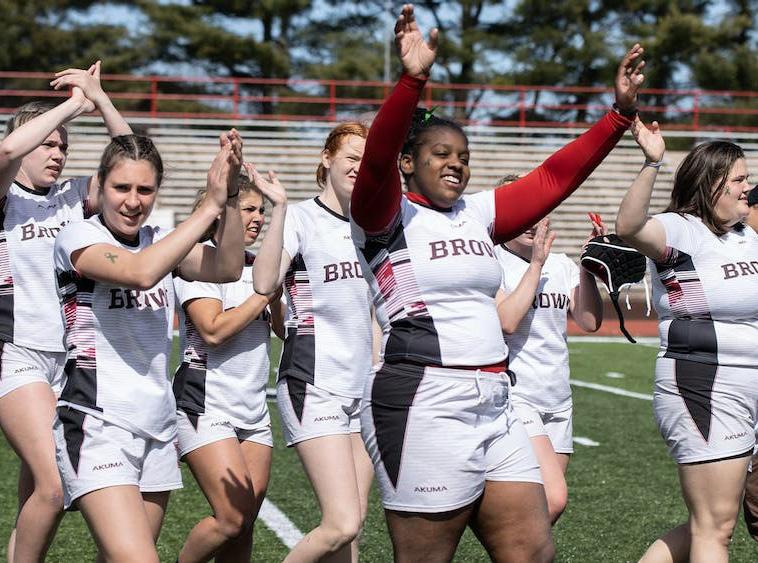
“Over the season, we have really improved in confidence in (ourselves) as well as in our teammates,” wrote Mahdia p arker ’23 in a message to The Herald via Brown Athletics. “At training, we have been working hard at maintaining composure … and a high level of physicality,” she added. “The result of that hard work was shown on s aturday.”
Under three minutes into the game, p arker received the ball at the halfway line. p ursued by Vassar defenders, she sidestepped her opponents, rushing 50 meters down the sideline for the Bears’ first try of the day. After a successful conversion by Julia Murray ’26, Brown took a 7-0 lead.
Over the next ten minutes, the Bears increased their advantage to 19-0 through successful tries by Akilah Cathey ’25 and Morgan Cunningham ’24, with a conversion by Murray on the latter try. In the 14th
SPORTS
Over the course of the second half, the Brewers were unable to contest the Bears’ unrelenting attack.
minute, p arker scored her second try of the day after another 50-meter rush, advancing the Bears’ lead to 26-0.
The team is playing with “increased physicality and speed of play,” Head Coach Rosalind Chou wrote in a message to The Herald via Brown Athletics. “We are moving the ball nicely and have a lot of attack threats.”
Thirty-one minutes into the
game, Cathey put that physicality on display. With the ball in hand, she dashed for the try zone from twenty meters out. Despite being pursued by four Vassar opponents, she was not slowed down, dragging multiple defenders with her into the try zone to score.
“Our confidence as a team (has increased),” Cathey wrote in a message to The Herald. “ s o did our chemistry and skill.”
Five minutes later, Cathey scored again — this time from 60 meters out. As she ran down the left side of the field, she stiff-armed two Vassar defenders, fending off the opponents blocking her way. The crowd erupted with cheers as she touched the ball down to take a 38-0 lead for Brown.
Immediately following another Murray conversion — bringing the score to 40-0 — the Brewers lined up for the kickoff and pinned the Bears
deep in their own territory. But then Emerson Goodrich ’23 corralled the ball in her own try zone. Confronted by a Vassar defender just five meters into her run, she sidestepped the defender, making her opponent miss. Then, in an all-out sprint, Goodrich returned the ball down the entire length of the field to score her first try of the day. After a successful conversion, Bruno entered halftime up 47-0. Less than a minute into the second half, p arker scored for the third time, helping Brown pull away 52-0. Over the course of the second half, the Brewers were unable to contest the Bears’ unrelenting attack. Bruno — through tries by Elizabeth Mahoney ’25, Kate Molloy ’23 and Goodrich — finished the game in dominant fashion, winning 71-0.
Now, the Bears will look ahead to the Ivy League 7s Championship on April 22 in Hanover, New Hampshire.
“We enjoy being physical and showcasing our power in contact and we want to keep that trend going into Ivys,” wrote p arker. “We have a goal to be the best 7s defense in the league and this next tournament will be a great platform to implement some of the defensive skills we have worked on in training since” the Crimson 7s tournament at Harvard.
“We have some things to work on, but we will be ready come Ivy 7s,” Cathey added. “My goal for the tournament is to be as much of an asset to my team as I can and bring the Ivy title home.”
Women’s tennis defeats Harvard 4-2 to remain undefeated in Ivy play
Despite
BY AUSTIN XIANG SENIOR STAFF WRITERThe women’s tennis team (15-6, 3-0 Ivy) defeated Harvard (10-8, 2-1 Ivy) by a score of 4-2 at home on s unday afternoon, continuing their strong run against Ivy opponents this season. The win also extended the team’s win streak to four matches.
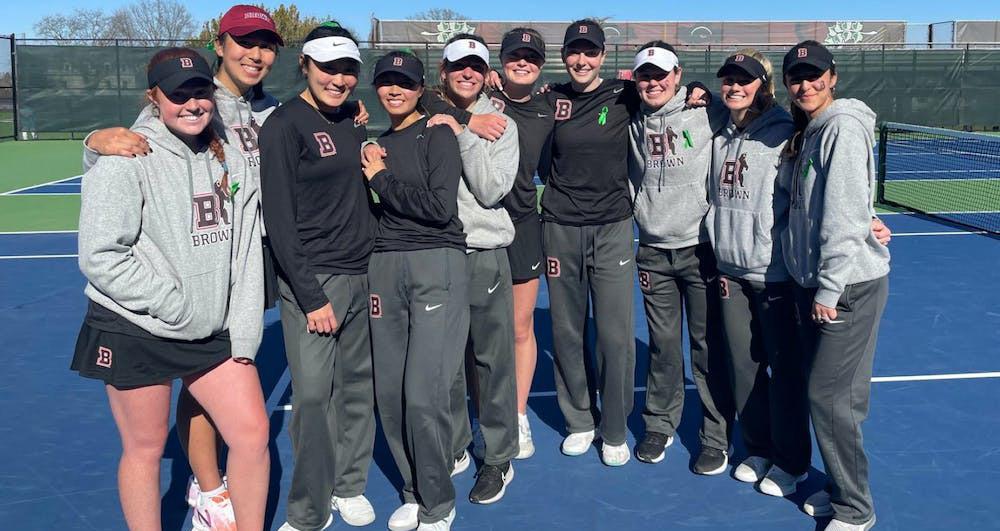
Harvard had the upper hand entering singles play, up 1-0 after Bruno dropped the doubles point with losses in second and third doubles.
“I think we came out a little nervous in doubles and (our) energy wasn’t as good as it normally is for us,” Head Coach Lucie s chmidhauser said. “But definitely I still felt that in terms of the matchups in singles, we could still come through.”
Bruno responded by picking up the first singles point courtesy of Ali Benedetto ’24, who defeated her opponent with a pair of 6-1 victories.
“I knew that (my opponent) was a really good player off the baseline, and I needed to do everything I could to make her uncomfortable. I think I did a really good job of taking her out of her comfort zone,” Benedetto said. “ s he’s a freshman, so she doesn’t really have that experience. I knew if I could get on top of this girl early and knock her down a little bit, she wouldn’t come back. And that’s what I did.”
s chmidhauser said Benedetto’s dominant victory allowed the team to feel like they were “really in it.”
“ s he definitely set the tone because she was off the court in less than an hour,” s chmidhauser said.
“That really evened out the whole match for us after losing the doubles point.”
The Bears lost at second singles to give Harvard a 2-1 lead, but Lindsey Hofflander ’25 evened the score at two apiece with a victory in fifth singles (7-5, 6-3). In fourth singles, p hoebe peus ’26 secured a hardfought victory despite dropping the
first set (4-6, 6-0, 6-4) to give Bruno the 3-2 lead.
“It was really great to see the turnaround and energy and focus for singles — everyone came out just really ready to go,” s chmidhauser said. “Even the players who maybe lost the first set or were down, they just kept coming back and kept competing. That made a big difference.”
With Brown needing just one more point in either third or sixth singles to defeat Harvard, Britany Lau ’23 rose to the occasion. In the game-deciding match, Lau picked up Bruno’s fourth and final point of the
day with a come-from-behind 6-4 victory in the third set after splitting the first two with Harvard’s s ophia Ho. The match ended with a score of 4-2, with sixth singles between Addison Ahlstrom ’25 and her Crimson opponent remaining unfinished.
“Really just sticking to my gameplan and knowing what was working and how to make the other girl uncomfortable” allowed me to be effective, Lau said. “Just staying in there (and) making the girl hit amazing shots to beat me was really the way that I won the match today.”
“Brit battled so hard,” schmidhau-
ser said. “ s he was down in the third set but just kept competing, kept coming back at the girl. It’s a great feeling to have a senior playing in the deciding match because you know she has that experience and she has that toughness.”
The team will continue its Ivy League series at p rinceton (12-6, 3-0 Ivy) this s aturday at 1 p.m. “We’re going to prepare in the same way, treat every match the same,” Lau said. “Just keep practicing, keep training hard, treat every practice as a match and really just go out there and play our hearts out.”

